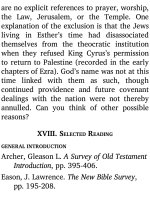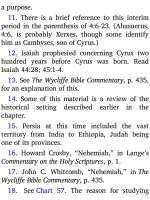Jensens survey of the old testament adam 128
Bạn đang xem bản rút gọn của tài liệu. Xem và tải ngay bản đầy đủ của tài liệu tại đây (199.46 KB, 4 trang )
14
Ezra, Nehemiah and Esther:
Return of the Jewish Remnant
from Exile
Ezra, Nehemiah, and Esther are the last
three books classi ed under the historical
section of our English Old Testament. The
rst two report the ful llment of the earlier
prophecies that after seventy years of
captivity God would gather His people and
bring them back to the land of Canaan (e.g.,
Jer 29:10-14).1 Thus, the historical portion
of the Old Testament ends on a bright note.
The restoration of Israel, in their
regathering to the homeland of Canaan, was
important for various reasons. For Israel, it
showed that God had not forgotten His
promise to Abraham concerning the land of
Canaan (e.g., read Gen 13:15 and note the
strength of the phrase “forever”). Hence, the
relocation of a returning remnant. Hope for a
missionary outreach to Gentiles was stirred
up in the revival of true worship, for a key
mission of Israel was to show heathen
nations of the world what true worship of
the true God was. And then, the restoration
was directly related to the life and ministry
of the coming Messiah, in the renewal of the
Messianic
promises.
For
example,
Bethlehem, Nazareth, and Zion were some of
the geographical places woven into the
promises concerning Jesus’ coming. In about
four hundred years Jesus would be born of
the seed of David in Bethlehem, not in
Babylon. The Holy Land of promise, not a
land of captivity, was where His people
would be dwelling when He would come
unto them, “His own” (John 1:11).
I. PREPARATION FOR STUDY
1. Note the location of these books in the
Old Testament canon. Chronologically, the
group is correctly located in our Bibles,
because here are recorded the last events of
Old Testament history (i.e., up to about 425
B.C.). But the historical setting of these books
is often obscured in the mind of the Bible
reader, because the books that follow them
(poetical and prophetical books, through
Zephaniah) in our present Bible arrangement
actually revert back in time. Chart 55 shows
the chronological setting of these last three
historical books (Ezra, Nehemiah, Esther).
2. The best preparation for the study of
Ezra, Nehemiah, and Esther is a review of
the books immediately preceding them:
Kings and Chronicles. Recall that these latter
books record the successes and failures of
the two kingdoms of God’s chosen people—
Israel and Judah—and of their eventual fall
and captivity in foreign lands as a divine
judgment for sin. The overall account is a
classic illustration of the eternal law of
returns, a law of cause and e ect. The e ect
was judgment; the cause was sin.
When we come to Ezra and Nehemiah, we









